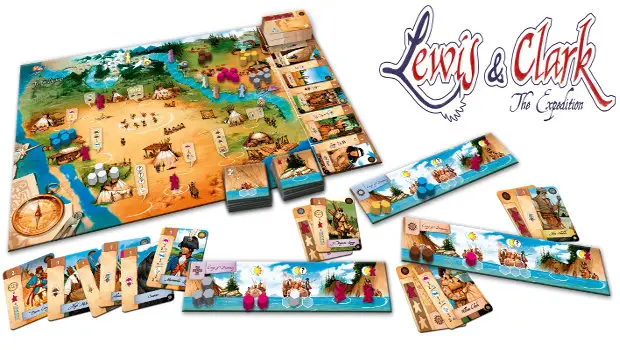Wine, cuisine, and tires.
Whether a luscious white from Alsace or a smooth Bordeaux, wines from France can’t be beat. The finest meal I’ve ever had—$500 (in ‘96) for my wife and I—came in a Paris restaurant overlooking the Eiffel Tower. When I want the best car tire, it’s strictly Gallic pour moi: Michelin.
While “France wins” is almost never uttered on the battlefield, the French beat the world in wine, cuisine, and tires. Increasingly, they’re besting the world, even the Germans, in board game design. Companies like Asmodee, Matagot, Libellud, Bombyx, Ystari, Fun Forge, Gigamic, and Days of Wonder (part American, part French) are delivering outstanding games that look gorgeous.
Add tiny Ludonaute to that list. With the release of Lewis & Clark: The Expedition, another French publisher has crafted a world-class game.
Comprenez-vous American history?
Americans know Meriwether Lewis and William Clark from history books. The explorers’ May 1804 to September 1806 expedition charted the American Northwest and blazed a waterway trail to the Pacific. An extraordinary scientific, sociological, and geographic success, that trek across America stands as the pinnacle of exploration in the minds of most Americans.
Though a French company telling Americans their own history through a board game is something of a headscratcher, thank heavens they did, because Lewis & Clark is one of the best historical board games ever made. Not only does it excel in its game play and thematic integration, but outside of a textbook, nothing packs so much history into cardboard, wood, and paper.
Like the actual expedition, the object of the game is to chart the Louisiana Purchase territory President Jefferson bought for the U.S. from Napoleon (there’s your French connection) by traveling through America’s waterways from St. Louis to Fort Clatsop in what would become Oregon state. First player to camp at Clatsop or beyond wins.
Wow, just wow
Though Lewis & Clark debuted in late 2013, only now is the revised English edition available in quantity. Asmodee, the powerhouse French publisher and distributor, distributes it in the U.S.
[singlepic id=18514 w=620 h=350 float=center]
Inside the box:
- 1 Game board
- 84 Character cards
- 5 Player expedition boards
- 12 Boat tiles, double-sided
- 10 Route change tokens
- 8 Resource badge tokens (solo play)
- 8 Resource multiplication markers
- 5 Camp tokens
- 5 Scout figures
- 18 Indian figures
- 100 Resource hexagons (wood, fur, equipment, food)
- 1 Rulebook (16 pages)
Lewis & Clark is the first game designed by Cédrick Chaboussit, and he gets kudos not only for the play of the game, but also for its historicity. Each character card in the game features a true-to-life expedition party member. The card’s abilities reflect that member’s actual assistance rendered. Even better, the rulebook provides a small paragraph discussing that person’s impact on the journey. Such attention to detail makes the game remarkable and an unexpected history lesson. Aside from facts about the expedition, the rulebook walks straight through the hows and whys of game play, making Lewis & Clark easy to learn.
This game looks spectacular. Artist Vincent Dutrait channels American illustrator N.C. Wyeth and breathes life into both the characters encountered on the expedition and the verdant landscapes of the American Northwest.
The linen-finished cards use both sides for game play. Though thin, they seem well made, and they shuffle easily. However, to preserve them and their beautiful artwork, consider card sleeves. Two packs of 50 Mayday Games premium standard size (63.5mm x 88mm) fit these cards perfectly and will still store nicely in the generous plastic insert in the game box.
The wooden hexagons that represent wood (brown), fur (yellow), food (pink), and equipment (gray) are a decent size. For fans of stickers, the Board Game Geek Store sells a promotional sheet of stickers for the game that can be affixed to the wooden hexagons to better depict those resources.
The meeples go beyond ordinary, cut to resemble Indians (complete with feathered headdress) or the color-coded scouts for each player’s team. Even better: The Indian meeples fit into a space on the back of some cards to enhance the strength of the card, a nice design consideration.
The one not-so-nice design choice concerns a major part of how the game plays. Players must consider the resource types of other players’ cards when making decisions. This demands clear iconography to easily determine card types. Sadly, the design of this element on each card is within a bold-lined circle, filled with the color and tiny image of that resource. If only the design had omitted the circle and just gone with a large, colored depiction of the resource alone, its physical shape helping to differentiate it. As it stands, players (colorblind or not) may have trouble telling these apart from across a table, a major fail in an otherwise well-designed game.
One other issue: The cards and game board in Lewis & Clark feature wordless iconography, but it isn’t as comprehensible as it might have been. Even veteran players may ask for the rulebook to clarify what icons mean. That should never happen in a game past the first play. The wide variety of icons only worsens the issue.
Journey into the unexplored
The rules for Lewis & Clark make sense and are simple for a game of this depth. What pushes this game into a weight of medium-heavy is the brain-burning number of options for optimizing play. (For game play details not covered in this review, consult the rulebook.)
A brief overview of game play…
Each player receives a set of six character cards, each set possessing the same capabilities (resource production, movement up a river or across mountains, and language translation). Each character card in the party is unique—again, a nice, historical touch. Lewis’s set even includes his dog.
Each player must play a character card from in-hand OR play one Indian meeple to the Indian village on the game board to perform an action there. Additional actions may include recruiting a character card from the Journal of Encounters area on the right side of the board, moving the team’s scout up the river or through the mountains, and/or setting up camp.
[singlepic id=18515 w=620 h=350 float=center]
On the obverse, the character cards feature the following:
- A large, white number, 1-3, in the upper left, that reflects recruitment cost and strength
- The resource the character provides, in the upper right
- An icon or icon set, on the left side, that details the card’s capability
- Artwork depicting the character and the character’s name
- A team icon or number in the lower right that determines the character’s team set or cross-references to the rulebook to expain the card further and provide history into the character
On the reverse:
- The resource the character provides, in the upper left
- A camp time reminder, upper right
- The character’s strength, 1-3, left
- A starting team, if any, bottom
- An equipment recruitment discount, bottom right
Activate a character card by pairing it (usually) with a face-down character card. Icons on the obverse of the played character depict the card’s capability. The reverse of the second card shows one to three Indian icons (strength) that tell how many times a player can use the obverse side of the first card in one turn. In addition, if a player has available Indian meeples, those can be added to the empty Indian slots on the reverse side of the second card to boost strength or can be played alone onto a character card without the use of a second card. Lastly, with those cards that gather resources, players multiply the strength of the second card by the sum of all the character cards of that same resource type in play by the player and the immediate players on the left and right (à la 7 Wonders). The player who played can then gather up to that many of the desired resource.
Storing/transporting resources is always tricky. Each player board depicts boats that can carry resources or Indian helpers. The leftmost boat carries two resources, the next over can manage three but if used will push back an expedition by a space when it needs to camp. The next boat over carries five resources, but each resource in the boat will push the expedition back one space at encampment time. Next over is a spot for one Indian helper, followed by a second spot for multiple Indian helpers that will push back encampment for each. In addition, players can use three wood in the Indian village to add more boats to carry additional resources and Indian helpers. Each added boat tile has two sides, each with differing resource/Indian accumulation benefits and encampment penalties.
The Indian village on the main game board provides both raw resources and finished goods. Players can place their Indian meeples on village circles and semicircles to gain additional resources, buy canoes and horses, reuse a played character’s abilities, and clear out cards from one’s hand and from the Journal of Encounters area.
Journal of Encounters on the right side of the board is where the numbered character cards arrive. Five cards from the deck are always in play for possible recruitment by any player. Pay the recruitment cost and the card joins the player’s deck. The cost is calculated in a clever way by multiplying its strength by the icon cost above that strength in the Encounter slot the card occupies. As players take cards, the cards slide down the row and their cost decreases.
If a player performs an action that involves movement through the mountains or along the river, the player’s scout moves forward as far as the icon/strength/resource combo affords. A player may encamp penalty-free at the scout’s location if no more cards are left in-hand and no boats on the player’s board have resources in spots that penalize. Encampment is still possible with cards in-hand and boat storage overflow, but from the scout’s position the camp is moved back a space for each leftover card in-hand and as calculated from resource allocation and Indian helper penalties on the player’s board. Encampment permits the player to take all played cards back in-hand for play later and also clears the player’s tableau, so other players cannot count that player’s card’s resource types when calculating resource payouts. In short, move forward AND deplete the other players—if there ARE other players.
A rarity in a non-cooperative Eurogame, Lewis & Clark plays solo. In fact, soloing is a great way to learn the game before teaching a group. Since a soloist cannot multiply resources by other players’ played cards, the soloist seeds the Indian village with resources that serve as a multiplier of a given type if the soloist has already played an Indian to a circle/semicircle that corresponds to that resource. A lone scout, Alexander Mackenzie, opposes the solo player and moves forward one space after the soloist’s turn. The soloist must beat the relentless Mackenzie to Fort Clatsop and camp before the robo-foe reaches the fort. Adjust Mackenzies’ lead to increase difficulty. (With a one space starting lead on me, I beat Mackenzie handily, though I was fortunate to recruit early two of the most powerful characters for doing so, Daniel Boone and Half Man. Boone let me spend two resources and move upriver as many spots as Indian meeples in the village, while Half Man let me spend one resource to move as many river spaces as scouts on or ahead of my camp, which was always two.)
Manage Indian helpers, character capabilities in your party, and resources to get your expedition to Fort Clatsop first. Sound easy? Not in the slightest! And that’s what makes Lewis & Clark such a challenging, intense game.
[singlepic id=18513 w=620 h=350 float=center]
Holy Sacagawea this game is good
From the eye-catching artwork to the mind-bending expedition management as you creep along the river, only to be stymied by a lack of horses in the looming mountains, Lewis & Clark is phenomenal, easily one of the best board games of 2013. From a first-time designer? Inconceivable!
What does this game do right?
The theme is excellent, and the rulebook’s historical featurettes on each of the 84 characters is unlike anything I’ve seen in any game. That the designer leverages the capabilities of those characters realistically is a staggering effort. Mega-kudos.
Theme integration extends to play. You feel like you’re managing a real expedition, maximizing opportunities and relationships as they come. Every turn is a challenge.
Given the variety of card types and abilities with which players build their in-hand card “engine,” plus worker placement options, replayability should be high. Players can plot multiple ways to achieve the same goal.
Heavens, this game looks great and raises its final score a notch on gorgeousness alone.
Solo play! A great way to learn the game or play when no one is around. Best of all, soloing remains great fun.
Lewis & Clark engages players so thoroughly that when the game is over, it may NOT be over. Some players may want to play to see who comes in second—or even third. That, too, is a rarity in gaming.
However, playing for second place raises one of a few detriments to the game that keep it from hitting that quasi-mystical 100 score on Gaming Trend.
Lewis & Clark can have a runaway leader issue. Good play in this game compounds, as does bad. If one player gets too far ahead, others may not catch up no matter how optimally they play. This game plays best with players of equal skill levels and rewards more plays and better understanding of the cards. Also, no good attack option exists in the base game, so players who fall behind can’t hinder a leader. Still, as noted above, that players want to keep playing after someone wins says something positive even in this negative.
Any game that “builds an engine” a player repeatedly accesses and refines can be solitaire-ish. Lewis & Clark’s solo mode gives this away. However, the worker placement aspect, character card selection, Journal of Encounters clearing capability, and resetting one’s hand to prevent resource multipliers do offer chances to interact by frustrating another player’s chosen play.
The aforementioned clarity problem when viewing resource icons on cards from across the table seems a mistake given how well everything else in the game works. Color issues worsen it—not a colorblind-friendly game..
Lastly, understanding the iconography will take time, as will understanding how the cards work together. Players will look at their hands and stare at the cards in the Journal of Encounters, the Indian village area, and their player boards with loaded boats and think, What the heck do I do with all this to achieve the goal? If it’s any consolation, Lewis and Clark themselves may have wondered the same thing at some point in their wilderness journey.
Just buy it!
When I brought Lewis & Clark to game night, several attendees had played it the week before, but all were eager to play again. That almost never occurs with other games, no matter how hot. What a great endorsement.
If you’re looking for a game with a solid historical theme, Lewis & Clark is a no-brainer buy. In fact, the most highly regarded games of 2013 were built on history and did so by skillfully integrating theme and play. Add Lewis & Clark to Francis Drake, Expedition: Northwest Passage, Freedom: The Underground Railroad, and 1775 Rebellion as a stellar example of how to do a historical game right. Cannot recommend this one highly enough. If you can overcome some of the learning curve with the card iconography and capabilities and have a game group committed to playing the game more than a couple times, it will provide many hours of exciting group play—and solo play too!
So, Francophiles unite! Now you can drink a Château d’Yquem while partaking of your local bistro Français, drive home on your Michelin-tired car, and enjoy a fabulous French game too—even if it is about American history.
Game Name: Lewis & Clark: The Expedition
Designer: Cédrick Chaboussit
Publisher:Ludonaute (distributed by Asmodee)
Year: 2013
Players: 1-5
Ages: 14+
Play time: 30 minutes per player
Mechanics: Card drafting, Hand management, Deck building, Worker placement, Racing
Weight: Medium-Heavy – “Difficult decision-making, though medium-weight rules”
MSRP: $49.99***
Freelance writer, editor, marketer, and more. Enjoy birding, geocaching, reading, drumming, and of course, board gaming.
Been playing board games since the 1960s. Have owned all the classics--Dark Tower, Bermuda Triangle, PanzerBlitz, Fireball Island, Magic Realm, and more. Got into RPGs with D&D and AD&D back in the late 1970s.
Today, I'm primarily a Eurogamer, and I play a little Pathfinder. Favorite games include: Tzolkin: The Mayan Calendar, Airlines Europe, 7 Wonders, Power Grid, Lords of Waterdeep, Seasons, Puerto Rico, and Hanabi.

One of the best historic-themed games in recent memory, Lewis & Clark: The Expedition is a gorgeous-looking, challenging blend of card management, worker placement, and racing. The cards incorporate real members of Lewis and Clark's party, along with their skills. Can even be played solo. With excellent replayability, it's a great value too.
PROS
- Spectacular artwork
- Outstanding incorporation of theme and history
- Challenging group and solo play, with excellent replayability
CONS
- Some frustrating-to-decipher iconography
- Some icons difficult to discern from across the table
- May have runaway leader issues, no catch-up ability
See below for our list of partners and affiliates:

























